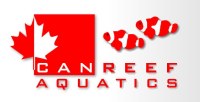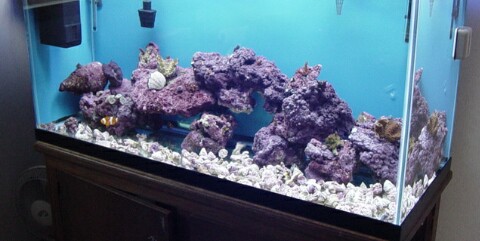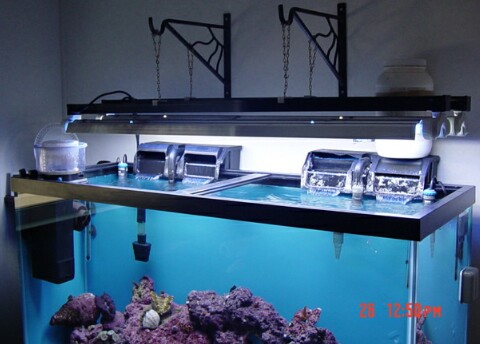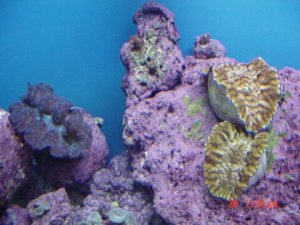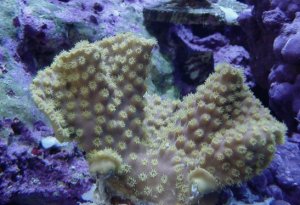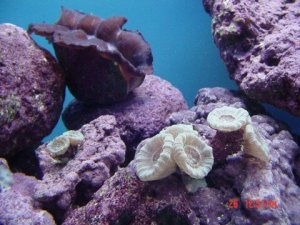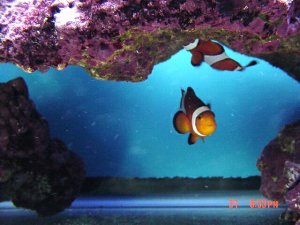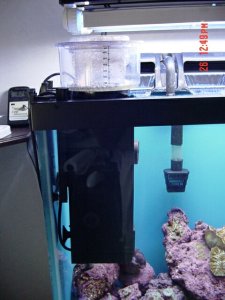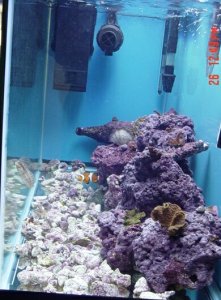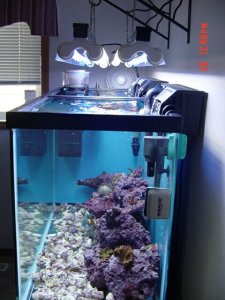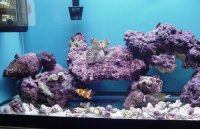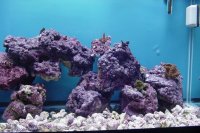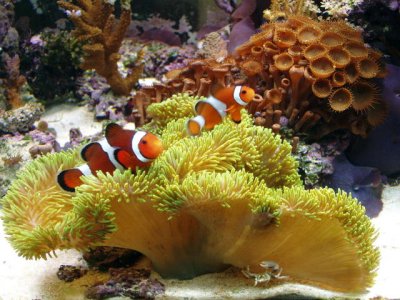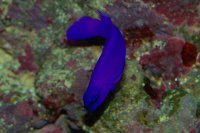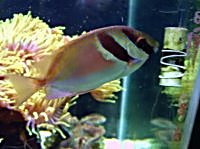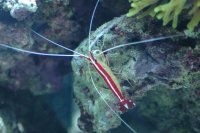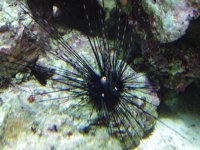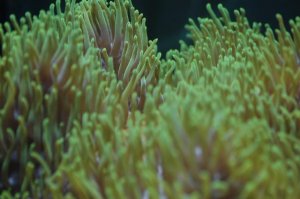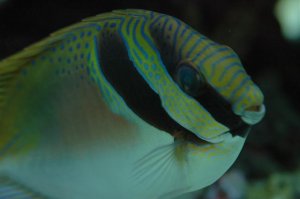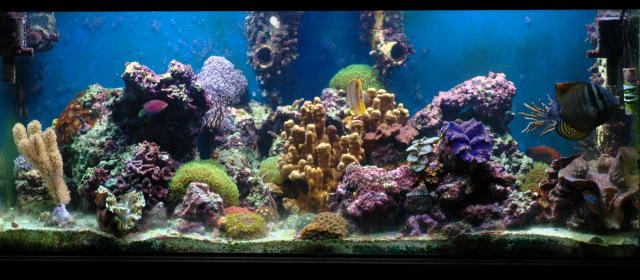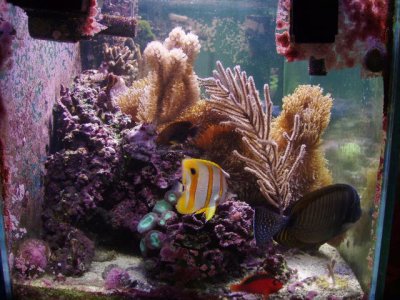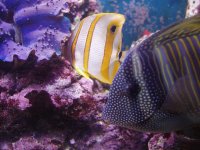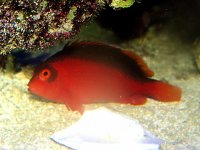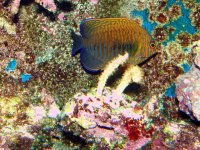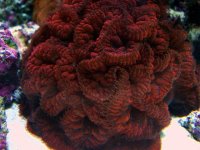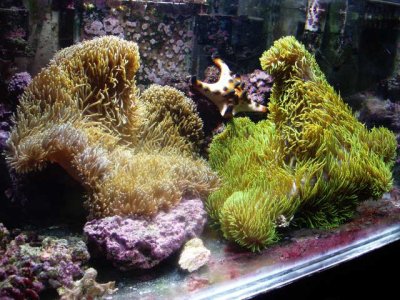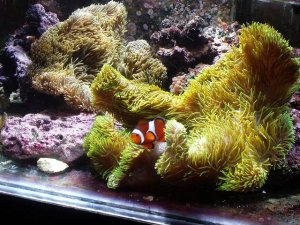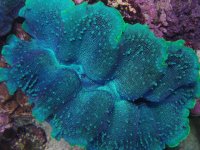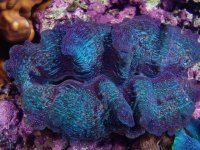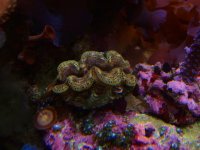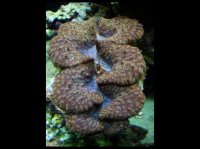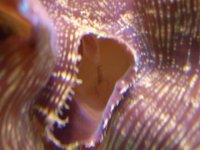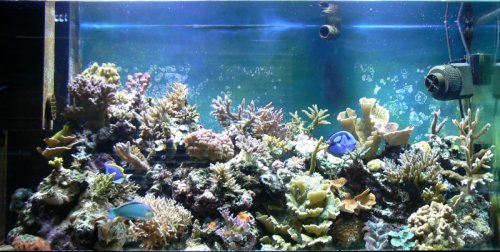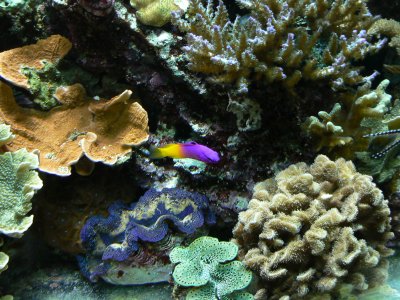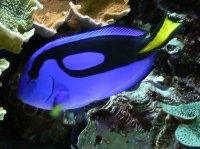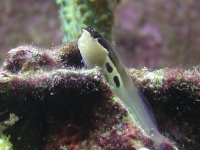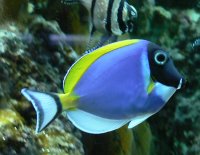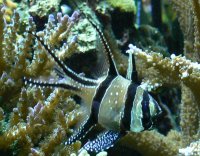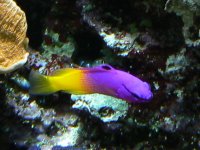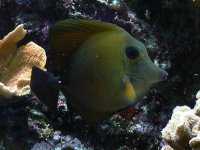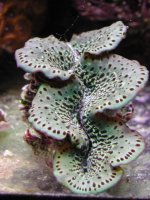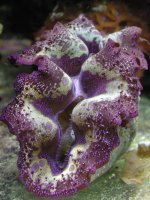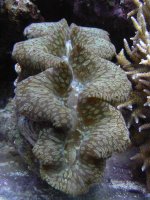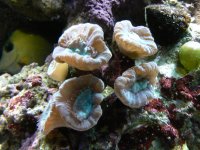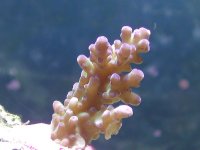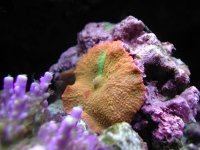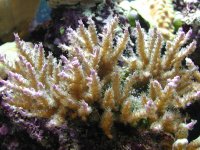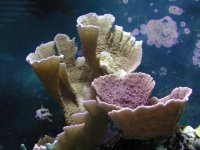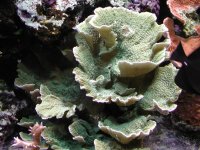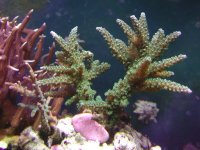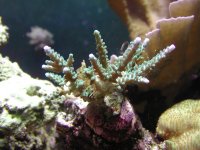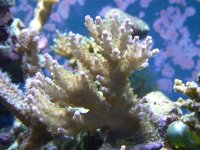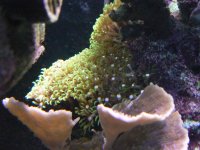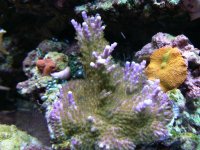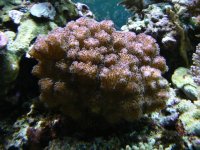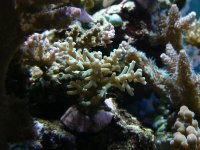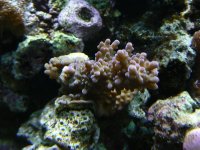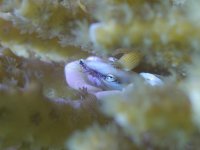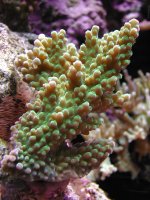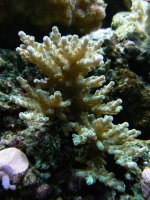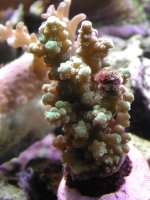| Main Menu |
| Home Bulletin Board Photo Gallery Recommend Us User CP Contact Us |
| Moderators |
| Titus Christy Doug Tony Brad |
|
The 40g Carpet/Clown tank
Despite many shifting interests in the hobby, I've always come home to anemones. From a period of about 4 years, I decided I wanted to try a Stichodactyla gigantea carpet. This is considered by some to be the Holy Grail of anemonekeeping, and I can certainly attest that it was an interesting challenge to acquire a specimen. From a period of about 1999 to 2004, I would visit every LFS in Calgary every week to see what would come in on that week's shipment. And never once did I see this species come in. My search became an obsession. I would see this species in the U.S. when I would go down for site trips for work, but I never came home with one, for not knowing what would happen at the border. (As it happens, I fretted for naught, as anemones are not on CITES. But hindsight is 20/20!)
|
The process of searching, and not finding, became so silly, in fact, that during this time, I bought a wicked green haddoni anemone, which in 1999 was a mere 8" in diameter. In 2003, at nearly 20" diameter, it had completely outgrown any system I could afford to set up at the time, so the decision was made to sell it to a better home. So my "consolation prize" came and went before I even found a gigantea carpet. That haddoni carpet has had an interesting time. It bounced around from tank to tank in the Calgary area before finding its way to Creston, and now in fact is in Saskatchewan somewhere if I understand correctly. If anemones could talk, the stories that anemone could tell!
But, the search eventually did prove fruitful. In 2004 I found a carpet that was unmistakably S. gigantea. A year later, I found a little green S. gigantea. This 40g tank is the tank they now reside in. They are outgrowing their tank so soon I will have to build them a new system, but for now, they are holding their own. My hope is to one day explore the possibility of spawning these anemones to see if the offspring could be successfully reared. Anything we can do to reduce the pressure of collection in the wild, surely is a good thing. |
S. gigantea is an absolutely beautiful anemone. Like H. magnifica, these are shallow water animals, so that tells us what kind of currents and lighting for them should be used. Unlike H. magnifica however, these anemones prefer to shelter their pedal disk in a crevasse, rock, or even bury them so you likely find them at the sand/rock interface. They like intense light, but there is no need for a spotlight effect like with magnifica.
Interesting factoid about the latin naming of this species. When you "hear" gigantea, you think "gigantic." But, in actual fact, of the 3 Indo-Pacific clownfish hosting carpet anemone species, S. gigantea is in fact the smallest. S. haddoni and S. mertensii will handily outgrow this species and have maximum diameter sizes in the order of 24" and 30" respectively. So why are they called "giant" carpets? Story goes, when the species was first described, the European biologists had not seen a larger anemone so to them these were gigantic, and named the species thinking that these Red Sea specimens were the largest anemones in the world. I don't know if this is true or not, but, it makes for an amusing anecdote - the classical ice-breaker line at cocktail parties.
A couple years ago a lot of my live rock became infested with hydroids. I decided to try chocolate chip stars to see if they would clean the rock of them. It seems they did the job (eventually). But, over time, I grew fond enough of them to keep them. They are not generally regarded as good reef tank specimens due to their predatory nature. However, I thought it was a bit of a breath of fresh air to have a starfish whose diet we can actually predict. So, this tank became the home for these stars. They do not bother the clowns or anemones, and, if I find a rock with hydroids, into this tank it goes so the stars can clean it up.
Inhabitants:
2 Stichodactyla gigantea (giant carpet), Mating pair of Amphiprion ocellaris clownfish, Neopetrolisthes sp.,porcelain crab), Cypraea tigris (Tiger cowry), 2 Entacmaea quadricolor (rose BTA, gold BTA), 2 Protoreaster nodosus (chocolate chip star)
Equipment:
Lighting: 175W Iwasaki 14000K
Skimmer: (Shared sump with 75g tank)
Sump return: Mag5 into a SCWD which alternates flow to the left and right sides of the tank
Flow: 2xMJ1200 powerheads + 2xHagen 300 powerheads on a Red Sea Wavemaker
********************************************************************
Christy's 90 Gallon SPS Extravaganza
I've said it once and I'll say it again; this hobby can become amazingly addictive. Looking at my tank pic, can you guess what I've become addicted to? You guessed it, I'm an SPS junkie. None of that "plant 6 inches apart" gardening rules for me. I cram them in wherever there's space. I've never had the "pleasure" of growing out a tank of SPS frags before; something usually comes along and does them all in before that ever happens (see my threads on high temperatures, dinoflagellates and stupidity).
So I won't bore you with too many gory details on equipment and such although I suppose its necessary. I'll try to keep it short and sweet. This is sort of an abbreviated version of the normal TOTM anyways and man, I could go on for pages and pages about my tank. You'd probably fall asleep long before then (unless you're hardcore like me :P).
Ok on to the good stuff. My tank is 90 gallons of fun and excitement, (now with eurobracing!). Instead of saying its been running for x years, I'll just say I've been "successful" since 2005 when I finally ripped out the sandbed after a yearlong battle with dinoflagellates that ultimately destroyed all the corals (and a couple of fish) in my tank. I run a 30 gallon sump with some old live rock in there hanging out making detritus. I run a 50 micron sock on the intake because my overflow box likes to make the grossest algae (yet wildly colorful) that often gets into the sump along with other cooties. I have a Euroreef ES6-2 skimmer, and a couple of phosban reactors down there as well, one with phosban, one with carbon and a heater of some ilk. I think it's an Ebo-Jaeger. I appropriated a bunch of these years ago from an old job and am just working my way through them. I had one stick on a couple years ago but that didn't stop me from just selecting another one from the pile. There's also a float valve crammed in there that controls the DIY topoff setup I have concocted which basically consists of a john guest fitting and a large rubbermaid container. It's very complex and yes, I use RODI water. I have a rather green thumb so there wasn't any other choice really ;)
I run ozone on a regular basis (Sander Ozone Unit), my ORP hovers around 360 or so (Milwaukee ORP monitor). It's a smaller unit and I dose about 25-30mg into my tank which I believe is "underrated" for my tank size. I have a Schuran Jetstream Pico Calcium reactor that I just got awhile ago. I can't believe how small it is, yet still gets the job done. Now I have so much room under my stand for other junk! Yay!!
|
Ok on to stuff that actually hangs out in or on the tank. I have 2x250W Ushios in Lumenarc Mini A3 reflectors running on M58 ballasts. They are "supplemented" by 2x110W VHO on an Icecap 440 ballast. I put supplemented in quotations as there was some error in measurements when I decided to go with the Lumenarc reflectors. The reflectors actually shade out a goodly portion of the actinic lighting (I'd say about 60-70% of it actually) but there's enough of a difference when they're off to notice so I run them anyways.
For water circulation I have a mag 12 running on a 3/4" Seaswirl (which is being cooked by the lighting due to yet another goofy measurement on my part) as well as two Tunze 6060s and a Tunze Wavebox. They keep everyone happy and while I thought having the two 6060s in there was "good enough", I had no idea until the wavebox was added. The polyps on some corals look like hands stretched out as far as they can go, it's absolutely amazing.
Ok on live things! I'm a biologist so I tend to have a bit more interest about live things rather than equipment (although, I'm more susceptible to the power of suggestion when it comes to equipment because I know so little). I have about 100lbs of rock or so and I have no idea what it is. I just called the store and said to send a box of rock. Likely it's Fiji or something like that. I've had most of it in the tank for about 5 years or so adding a few crab/worm infested pieces over the years (which I deeply regret doing, I am still finding evil crabs in there).
Ok I'll start with fish first. My oldest fish are my scopas tang and bangaii cardinal, both of which I got in 2003. Bug, the bangaii, came to me from Calgary as a tiny spawn in EmilyB's tank. He came complete with cocktail sword urchin (which I am kicking myself for not taking pictures of!). He has a bit of a gimpy jaw and reminds me of an old guy without his bottom teeth in. The scopas tang was a Canada day purchase from Victoria ("do you think the stores are open on a holiday? Lets go!"). That year I also added a tailspot wrasse who was the most personable fish in my tank and taught all the other fish that it was okay to come out when people were looking at the tank and that if you put on a show usually they would feed you! Sadly he passed away a couple months ago when he became too inquisitive about the goings on in my crocea clam who wasn't having any of that and promptly closed on his head. It was very upsetting.
|
|
|
In 2005 I added a regal tang from a friend who wanted to try freshwater discus for five minutes. A great deal for me as I inherited "Dory", the most skittish regal tang ever. Many a person has come to my house to see the tank and remarked, "uh is that fish ok?" Pretty funny as over the years, she has grown bigger (now about 5 or 6") and still manages to cram herself into places she can't fit. Finding Nemo certainly hit the nail on the head with these fish: they are a few bricks shy of a load.
With the addition of the regal tang, who is known to carry a few spots or two, I decided to go "eco friendly" and add a sharknose goby to the tank for ich management. Since then that goby has passed on (a heat incident in July of this year) but I cannot recommend them enough for fish cleaners. I've only had an ich breakout once and they did a fine job of cleaning up the mess. Unfortunately there wasn't anyone to clean them, but they pulled through with some extra feedings supplemented with garlic.
This May I added a 3" powder blue tang. I was rather reluctant to add this fish because of their reputation for being ich magnets and poor shippers. I managed to find a relatively healthy looking one and brought it home apprehensively. My scopas tang immediately went on the offense and harassed the PBT mercilessly. I don't know who was more stressed, me or the PBT. The PBT was confined to one corner of the tank under the wavebox for about 2 weeks when the scopas relented and let him have more space. About 6 weeks later all was well and the PBT even gets in to feed from the PVC nori feeder. He's also good about cleaning any algae off the rock and is turning into quite the fat little fish! Yay!! The last fish I added to the tank was another tailspot wrasse. I really missed my other one and this one became available when a fellow canreefer was taking his tank down. I just couldn't pass it up. His personality is much different from the first one but he's still a gorgeous addition to the tank. Albeit a fast one, I still haven't gotten a decent photo of him.
|
|
I have 3 clams, 2 maximas and 1 crocea. I acquired the first maxima as a fairly small specimen, about 3 inches or so, in 2005 and it has grown about 2 inches since. The 5" crocea I got earlier this year and it has done well in my tank. Recently I also added a 6" teardrop maxima. I've really gotten to be quite the clam hound lately and can't wait to find more to add to the tank.
Other inverts I have in the tank include a longspine urchin which came in as a pencil eraser size hitchhiker on some rock. I found it while moving earlier this year so it must have been super tiny on a coral or something. Suffice it to say, these guys grow fast!!!! Within 3 months it has a body the size of a mandarin orange and spines that are 7-9 inches long!! How it manages to hide now, I'll never know.
Another good hider in my tank is my abalone. The strangest critter, it only comes out at night and goes back to the exact same spot every morning (how does it know?!). It used to hang out at the front of the tank under a rock (where I would know it's still alive) but now it hangs out at the back of the tank behind some coral. I only know this because I was rearranging stuff one day but haven't looked since. Perhaps I should.
|
As for the corals, well quite frankly a picture is worth a thousand words anyways and while I could ramble on for a(nother) thousand words if I really wanted to, I'll save you the grief of having to read it and just say that I have Acropora, Porites, Seriatopora, Pocilipora, Montipora, Blastomussa and a few zoanthids in there that the Eunicid worm didn't finish off. Let's face it anyways, when it comes to corals there isn't much talking anyway, just a lot of drooling.
Thanks for letting us share our tanks with you!
|
